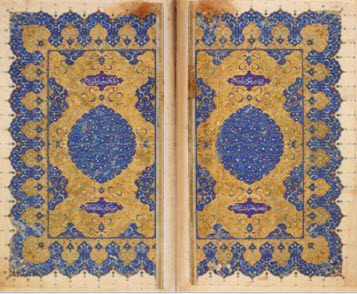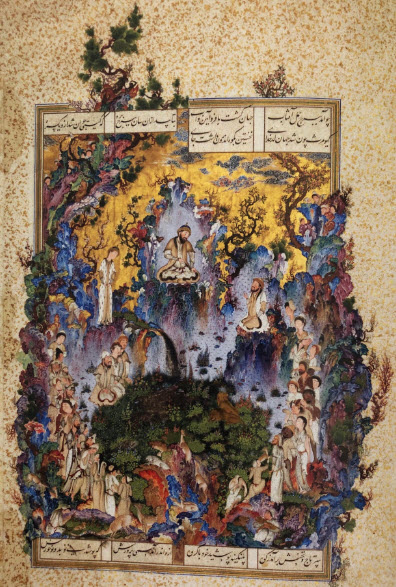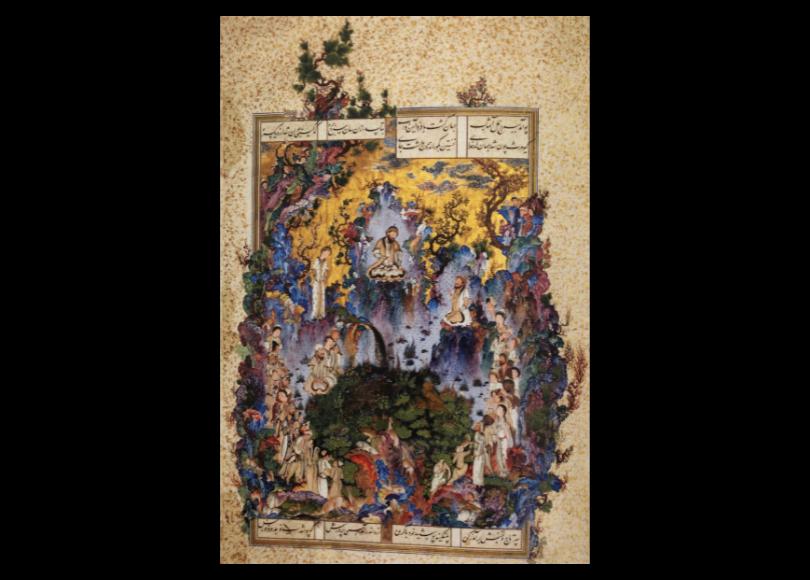Fearful that Persia’s history would be forgotten, Abu’l-Qasim Firdawsi (940-1020) composed the Shahnama (Book of Kings), comprising more than 60,000 rhyming couplets, telling the story of Persia (modern-day Iran) from the time of creation to its conquest by Muslims in the seventh century. Partly legend, partly historic, it is also a manual on kingship, a collection of heroic tales, and a long essay on wisdom, love, warfare, and magic, structured around four successive dynasties, each representing the various phases of human history, seen from the Persian perspective.

In addition to being a great work of literature, the poem was a ‘mirror for princes,’ a popular genre in medieval Islamic regions for the education of rulers. The models of conduct and teachings offered by the virtuous kings and heroes of the Shahnama explain its success throughout history.
The first part tells of the mythical creation of Persia and its earliest mythical past, beginning with the story of Kayumars (also spelled Kayomers), who was believed to be the world’s first human and the first legendary king (shah) of ancient Iran.
The name ‘Kayumars’ is the Persian form of Gayomard or Gayomart from the tradition of the Zoroastrian, one of the oldest monotheistic religions, founded by Prophet Zoroaster approximately 3,500 years ago. In Zoroastrian mythology, Kayumars had been granted supernatural powers by God, therefore, all animals and humans paid homage to him. During his thirty-year reign, Kayumars taught humans how to prepare food, introduced law and justice, and maintained harmony between animals and humans. The tranquillity was shattered when evil entered the world and the Black Demon killed Kayumars’s son Siyamak. In turn, Siyamak ’s son Hushang avenged the death of his father shortly before the death of Kayumars.
The second part of the Shahnama tells of the legendary kings and heroes; the third part blends historical fact with legend, telling of the semi-mythical adventures of actual historical kings.
The epic has been copied countless times. Comprising 759 text folios and 258 elaborate illustrations, the Shahnama made for Shah Tahmasp (r. 1524–76), the second shah of the Safavid dynasty (r. 1501-1732), represents the peak of sixteenth-century Persian art.

In the illustration titled Court of Kayumars, considered “a painting that humbles all artists,”1 Gayumars is seated before his community, all clad in leopard furs and skins, his son Siyamak seated to his left, and grandson Hushang standing to his right, implying the succession between father and son, although this never takes place due to the tragedy of the story.
The courtiers “stand in a circle, because the circle is the symbol of the sky in Persian thinking, and the sky in turn symbolises the universe. The courtiers standing in a circle send two messages. One is that Emperor Keyomars is the king of the universe, a standard eulogy, and the other is that the courtiers represent the emperor’s celestial court… The does shown reclining next to the peaceful felines transcribe a traditional literary image celebrating the just rule of the king that leads to universal harmony and safety for all” (Melikian-Chirvani, Pattern and Light p 51).
Lakhani notes that the King “is the prototype of the imago Dei or al-insan al-kamil (‘Perfect Man’). He represents the spiritually centred ruler who is the khalifa or [representative] of God on earth” (Faith and Ethics p xv).
The green grass represents spring in Persian poetry. The sky is painted gold “because gold is the colour of the sun, and therefore, of the light of glory shining upon the monarch. This signifies that the rule of Keyomars, sung as the first king of Iran in the Book of Kings, is the spring of Iranian kingship” (Melikian-Chirvani, Pattern and Light p 51).
The Court scene “descends from the celestial to the terrestrial, from the King to the Commons, reflecting the traditional devolution of order from the…kingdom of spiritual governance, symbolising the Spirit and its faculty of higher intellect, to the … kingdom of human governance, symbolising the soul and its faculty of the psyche, and thence to the subjects to be governed, symbolising the lower self and its appetites” (Lakhani, Faith and Ethics p xv).
Sources:
1 Treasures of the Aga Khan Museum, Masterpieces of Islamic Art p 216
Excerpt: Shahnameh, The Book of Kings, npr books
Assadullah Souren Melikian-Chirvani, “Discovering Art in the World of Islam,” Pattern and Light Aga Khan Museum, Skira Rizzoli Publications, 2014
